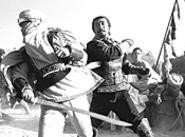Stop right there. Warriors of Heaven and Earth may be timed to capitalize on the popularity of Hero, but it is not the same kind of film. Both are set during a period of Chinese history in which people wielded swords and shot arrows, but the similarities pretty much end there. Expect wire-fu, recognizable Hong Kong stars, or even a plot that makes you think, and you'll be both disappointed and bored. Honestly, the first half of the movie is a bit boring regardless, but hang in there, and the payoff arrives.
The story takes place in the seventh century, during the Tang Dynasty, along the Silk Road that runs through the Gobi Desert from Turkey to China. In the narration voiced by Wen Zhu (Zhao Wei), which is apparently Chinese for "token female," we learn about her protector, Lai Xi (Nakai Kiichi), a soldier in the service of the Emperor, whose job it is not only to escort Wen Zhu to the capital city, but also to track down and kill a deserter by the name of Butcher Li (Jiang Wen).
Butcher Li's nickname turns out to be an ironic one -- his crime is that he didn't kill people when he was supposed to do so. He's a good guy, really; ordered to knock off several innocent Turkish women and children in captivity, he chose to revolt instead and now works as hired security for traveling merchants. Naturally, the one he chooses to escort through the desert this time around happens to be carrying much-sought-after cargo, a series of metal nesting-doll type contraptions that ultimately reveal magic pieces of something or other to do with the late Buddhist saint Sakyamuni.
Most interested is Master An (Wang Xueqi), the local robber baron, whose sense of style and delusions of musical skill mirror those of Eddie Murphy circa 1986. Already a pretty vicious adversary, he gets worse when the Great Khan of Turkey hires him to get the Buddhist artifact. An drives a hard bargain -- he insists on getting the Khan's daughter for his wife as part of the deal. This is readily agreed to, as the artifact allegedly gives its possessor total control over all Buddhist regions.
A decent setup and all, but it takes the movie about an hour to get through all that, plus all the lead actors are unfamiliar guys with beards, which makes them difficult to tell apart until they change into the more color-coded outfits they wear during the movie's second half. The fight scenes aren't big excitement-generators early on either. There are no fancy kung-fu moves here, just brutal, simple sword slashes. When things are moving fast and you haven't quite figured out who's who yet, it's hard to get into them, despite some really cool cinematography from Zhao Fei (Raise the Red Lantern).
Writer-director He may take a little too much of his sweet time, but he has the right idea: As we find out, he's saving the best action for later, when we have the characters and situation all straightened out. Be patient, and you'll be rewarded with a good old-fashioned castle siege that's worth the wait.
The first half of the movie is reminiscent of a western, with the dusty desert town, the robber-baron boss, and the honorable lawman who forms a temporary alliance with his equally honorable prey to fight for justice. Instead of heading toward a high-noon showdown, however, the film shifts gears into swashbuckling mode, with the appearance of supernatural objects and large-scale sword fights. It's a good move -- there are only so many ways to shoot a desert town, but take the characters on the road, and you can have forests, snowy mountains, and far more interesting buildings.
Still and all, it's hard not to pine just a little for a nicely choreographed one-on-one sword fight. It might be a wee bit less realistic than simple slashing, but so's the magical Buddhist artifact.


